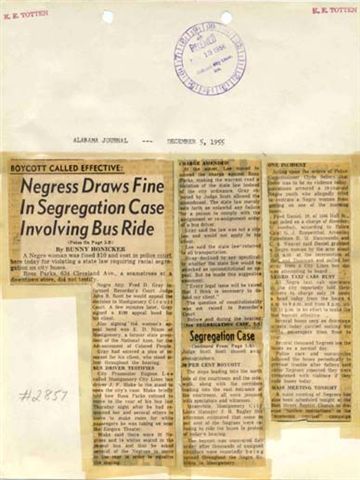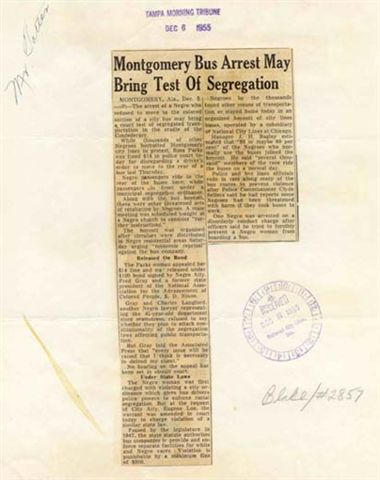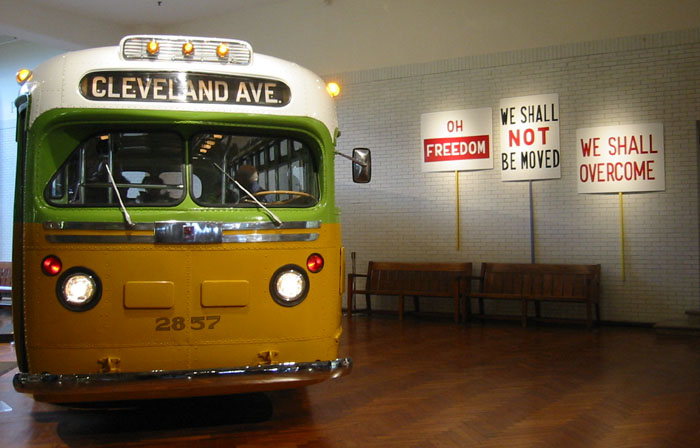By Donnie Williams

Because of Rosa Parks and many of the unknown Montgomery residents that were involved in the bus boycott and a lot more, Montgomery is a better place but we need to be better.
The Rosa Parks bus, the real one, is in Detroit at the Henry Ford Museum. It used to be here in Montgomery, but not anymore.
The owners wanted the bus scrapped after it quit running because it was THE bus. They lived in Chicago and owned most of the bus stations in the south in the 1950s.
Roy Hubert Summerford (my father-in-law) was a friend with the station manager and the dispatcher; they told him the Rosa Parks bus was about to forever be gone.
At the bus station, after 3 times being turned down to buy the bus, the owner finally agreed to sell the bus to Hubert. They said the bus would not ever run again without a new motor, but Hubert was very good with cars and trucks and I guess with buses too. After he paid for the bus he worked on it for about 30 minutes and cranked it up and droved it to his 10 acres of land outside the city limits of Montgomery. The bus went dead 3 times on the way to Hubert's land but it cranked back up and kept going. It was in the winter and Vivian and I were waiting on him to bring the bus to the land. We couldn't wait to see The Rosa Parks Bus; we couldn't believe they let that bus go.
Hubert said that the time for America to know about the bus was far from now (1970). The KKK was still very much active in Montgomery. He took on the job of taking care of the bus. He concealed the bus and kept its identity quiet. He feared that they would bomb it. Notice the Cleveland Ave. at the top of the bus. That is the name of the street route that the bus took everyday. As this driver got to a certain place he could roll a bar inside the bus over his head and change the street marker. In 1971 Hubert took it out of the bus and wrapped it in a blanket, then placed it in the closet to keep it safe. We only took it out when we took pictures of the bus. He also said that we would know when the time was right to tell about the bus.
Right away without telling anyone what was on his mind Hubert knew that bus was as important as the Liberty Bell. Hubert knew its proper place was in a museum.
The owner [of the bus station] was still upset with Rosa Parks and did not want that bus in a museum in Montgomery or anywhere. In 1970 the owner was still mad about the bus boycott of 1955 and 56. The boycott had cost the company $3,000 a day.
In 1985 Hubert passed away leaving the bus to his only child, my wife, Vivian Summerford Williams. I began to take care of the bus.
In the 1990s the Montgomery Advertiser newspaper found out about the bus and called me to do a story on the bus, but the time was not right and I said no. They sent a reporter out to the land; I don't know how they found out where the bus was, but they did. The reporter went to the bus without my permission and took pictures of the bus and put it on the front page of the paper and told America what the bus was and where it was. After that I had to check the bus everyday and had to run people away from it a lot. The KKK tried to catch it afire and shot holes in it. After that I had to rent a warehouse and store it inside under lock and key. This time they couldn't find it.
In 2000, the decision was made to sell the bus, so that the world could enjoy it. However selling was difficult because of proper identification. Everyone in Montgomery knew it was "The Bus." At the time Hubert purchased "The Bus," the employees informally passed on the information about the bus.
 Robert Lifson, President of Mastronet, Inc., an Internet auction house, decided he wanted to auction the bus for Vivian and me. He began a search for documents authenticating the bus. And he found them.
Robert Lifson, President of Mastronet, Inc., an Internet auction house, decided he wanted to auction the bus for Vivian and me. He began a search for documents authenticating the bus. And he found them.
Mr. Lifson contacted retired employees of the bus company, including Mrs. Margaret Cummings, widow of the former bus station manager, Charles Homer Cummings. Mrs. Cummings provided a scrapbook of newspaper clippings that her husband had kept during and after the Montgomery bus boycott of 1955-56.
National City Lines (which was the parent company of the Montgomery City Bus Lines) had employed a clipping service to clip and save any newspaper articles about the company’s bus service. Charles Cummings had kept the scrapbook of newspaper articles from the 1955-56 Montgomery bus boycott. Next to articles describing the arrest of Rosa Parks, he wrote "#2857" and "Blake/#2857." James Blake was the bus driver who had Rosa Parks arrested. Mr. Cummings’ relatives confirm that he jotted down the bus number because he felt the events were so important.
In September 2001, an article in the Wall Street Journal announced that the Rosa Parks bus would be available in an Internet auction in October.
 Museum staff began researching this opportunity. They spoke to people involved in the original 1955 events, to those who planned other museum exhibits, and to historians. A forensic document examiner was hired to see if the scrapbook was authentic. A museum conservator went to Montgomery to personally examine the bus. Convinced that this was the Rosa Parks bus, the Museum's leadership decided to bid on the bus in the Internet auction.
Museum staff began researching this opportunity. They spoke to people involved in the original 1955 events, to those who planned other museum exhibits, and to historians. A forensic document examiner was hired to see if the scrapbook was authentic. A museum conservator went to Montgomery to personally examine the bus. Convinced that this was the Rosa Parks bus, the Museum's leadership decided to bid on the bus in the Internet auction.
The Henry Ford museum entered the auction of October 25, 2001, and was the high bidder at $427,919. The other final bidders for the bus, both of whom were convinced of its authenticity, were the Smithsonian Institution and the city of Denver, Colorado.
At the same time, the Museum successfully bid on the Montgomery City Bus Lines scrapbook of newspaper articles with the Rosa Parks bus identified in two places. With additional grants the Henry Ford Museum has completely restored "The Bus."
My mother, Louise Williams had to ride the buses to and from work in the 1950s and knew other women who rode the bus and witnessed how the Blacks were treated and she chose to boycott the buses during the boycott also. She walked or rode a cab, but mostly walked.
I can't explain the feeling that I got everytime I got on that bus. It made me feel great; sometimes I even cried. Now everyone who gets to see and touch the bus at the museum can get to feel that too.
I wrote about the bus and the Montgomery Bus Boycott. The book is The Thunder of Angels. I did this for the people who were involved in the boycott and never got their story told. I believe God put this on me to do because of the bus and my mother’s bad experiences on the buses in the 50s. I got to meet a lot of the boycott soldiers who became my friends and they told their stories to me to tell.
Look up The Thunder of Angels: The Montgomery Bus Boycott and the People Who Broke the Back of Jim Crow by Donnie Williams and you will see a little about the book and myself. Beware I am a new author. I own a grocery store here in Montgomery. It took me 20 years to write this book.
Thanks, Donnie

Photos
All photos courtesy of Donnie Williams, except the final photo of the restored bus. Photo of restored bus by Erica Chappuis. Click on the two newspaper clippings to enlarge.
~
[Editor's note: It is an honor to publish this article by Donnie Williams for the 50th anniversary of the day when Rosa Parks refused to give up her seat to a white man on the Cleveland Avenue bus in Montgomery, Alabama. This article grew out of the correspondence between Mr. Williams and Marsha Joyner, after he found her latest piece on HungryBlues early in November. In that piece, Marsha was pictured in front of what she and many others had been led to believe was the original bus where Rosa Parks performed her momentous act of civil disobedience on Dec. 1, 1955. Fortunately, Mr. Williams has set the record straight with this teaser for his new book.
Marsha Joyner has posted an MS Word version of this article on the Dr. Martin Luther King Jr., Coalition-Hawaii website. --BG]







